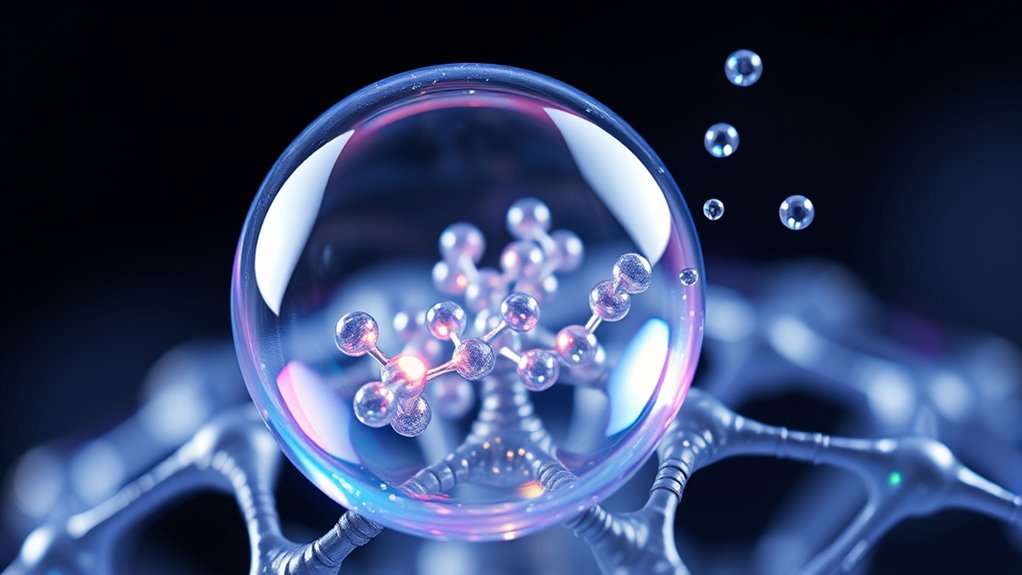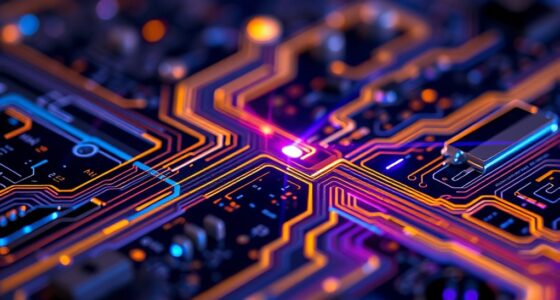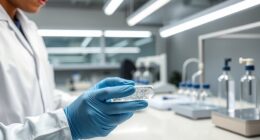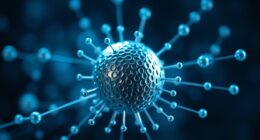Nanoencapsulation uses tiny carriers, like liposomes, micelles, or polymer nanoparticles, to protect sensitive molecules from environmental damage such as oxidation, light, or moisture. This technology improves stability, enhances bioavailability, and allows for targeted, controlled delivery of active ingredients across industries like pharmaceuticals, food, and cosmetics. Knowing how nanocarriers safeguard molecules can reveal benefits like longer shelf life and better effectiveness. Keep exploring to uncover how these tiny systems revolutionize protection and delivery!
Key Takeaways
- Nanoencapsulation encloses active molecules within nanocarriers to shield them from environmental damage like oxidation, light, and moisture.
- Nanocarriers such as liposomes and polymer nanoparticles provide a protective barrier, enhancing molecule stability during storage and application.
- Encapsulation controls the release rate of molecules, preventing premature degradation and ensuring sustained delivery.
- The nanocarrier material choice influences protection, safety, and targeted delivery of the encapsulated molecules.
- Nanoencapsulation improves bioavailability and efficacy by safeguarding sensitive molecules until they reach their target.
Understanding the Basics of Nanoencapsulation
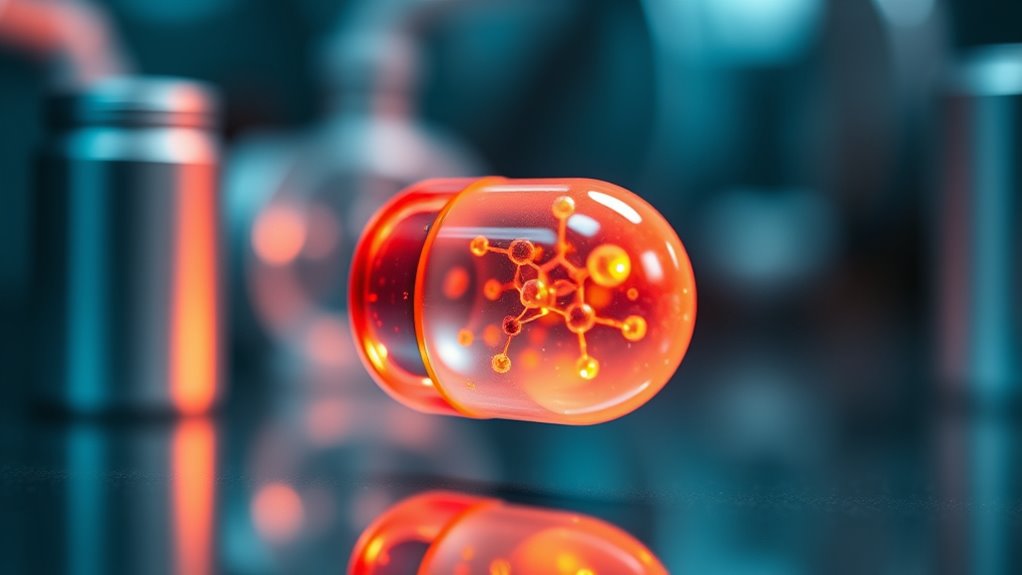
Nanoencapsulation is a process that involves enclosing active substances within tiny carriers at the nanoscale, typically ranging from 1 to 100 nanometers. This technique allows you to protect sensitive molecules from environmental damage, improve their stability, and control the release rate. When you use nanoencapsulation, you’re fundamentally packaging active ingredients in nanocarriers that can navigate biological systems more effectively. These nanocarriers can improve solubility, enhance bioavailability, and target specific sites within the body. By doing so, you optimize the efficacy of the active substances while minimizing side effects. Optimal angles for pinball machines studies show that precise adjustments can significantly influence performance and longevity. Understanding these basics helps you grasp how nanoencapsulation can revolutionize delivery systems across pharmaceuticals, cosmetics, and food industries, making molecules more functional and efficient in their applications.
Types of Nanocarriers Used in Delivery Systems

You should consider the different nanocarriers used in delivery systems, such as liposomes and micelles, which are known for their ability to encapsulate various molecules. Polymer and solid lipid nanoparticles offer stability and controlled release, making them suitable for diverse applications. Exploring these options helps you select the best carrier for your specific delivery needs. Additionally, understanding how automation in business can streamline manufacturing processes may enhance the scalability of nanocarrier production.
Liposomes and Micelles
Have you ever wondered how targeted delivery systems protect and transport sensitive compounds? Liposomes and micelles are two key nanocarriers that do this effectively. Liposomes are spherical vesicles with a phospholipid bilayer, encapsulating drugs or molecules inside their aqueous core. They mimic cell membranes, enabling biocompatibility and efficient delivery. Micelles, on the other hand, are formed by amphiphilic molecules that self-assemble into single-layer structures with a hydrophobic interior, ideal for carrying poorly water-soluble compounds. Both systems protect their cargo from degradation and improve bioavailability. Liposomes are especially useful for delivering large, hydrophilic molecules, while micelles excel with hydrophobic drugs. Their versatility makes them valuable tools in nanomedicine, enhancing targeted therapy and reducing side effects. Additionally, understanding the materials used in nanocarrier construction can further optimize their functionality and safety.
Polymer and Solid Lipids
Polymer and solid lipid nanocarriers are versatile platforms designed to improve the delivery and stability of therapeutic agents. You can customize these nanocarriers by choosing specific polymers or lipids to target particular tissues or control release rates. Polymers like PLGA, chitosan, and PEG provide biocompatibility and biodegradability, making them suitable for sustained or targeted delivery. Solid lipid nanoparticles (SLNs) and nanostructured lipid carriers (NLCs) offer excellent stability, protection against degradation, and controlled release of drugs. You might use these nanocarriers to enhance bioavailability, reduce toxicity, or improve drug solubility. Their adaptability allows for encapsulating a wide range of molecules, from small drugs to bioactive compounds, making them essential tools in advanced drug delivery systems. Additionally, controlled release mechanisms enabled by these nanocarriers can significantly improve therapeutic outcomes and patient compliance.
Methods for Fabricating Nanoencapsulated Structures
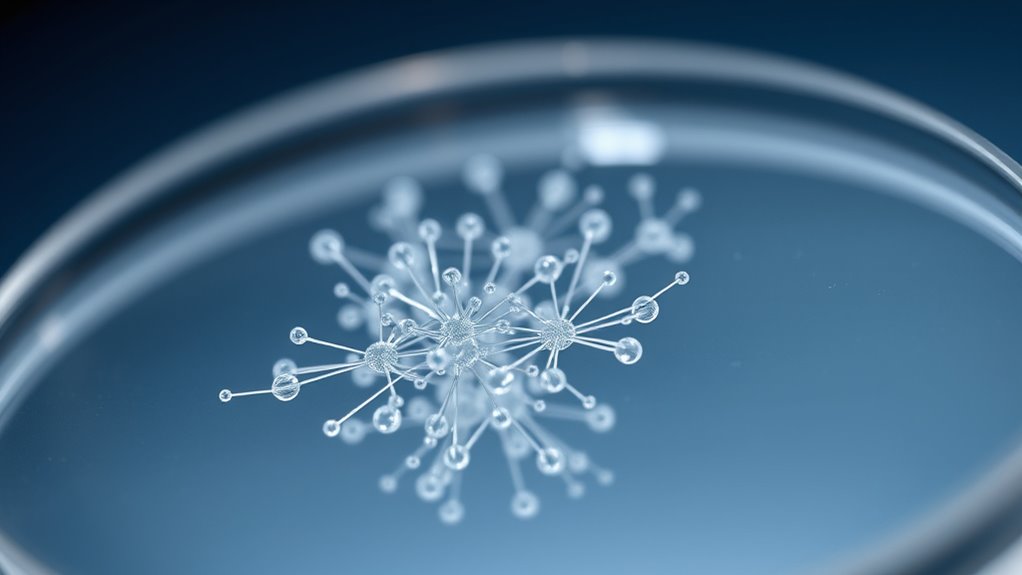
Several techniques exist for fabricating nanoencapsulated structures, each tailored to specific applications and materials. You might use methods like emulsification, solvent evaporation, or nanoprecipitation, depending on your needs. These techniques allow precise control over particle size, distribution, and payload stability. To visualize, consider this table:
| Method | Key Feature | Suitable Materials |
|---|---|---|
| Emulsification | Forms droplets via mixing | Lipids, polymers |
| Solvent Evaporation | Removes solvent to solidify core | Polymers, proteins |
| Nanoprecipitation | Rapid solvent diffusion | Polymers, drugs |
| Coacervation | Phase separation for coating | Polysaccharides, proteins |
| Layer-by-layer | Alternating layers build | Polyelectrolytes |
This table helps you imagine how each approach creates structures with unique properties for different applications. Additionally, understanding the material compatibility of each method is crucial for successful fabrication.
Advantages of Nanoencapsulation in Various Industries
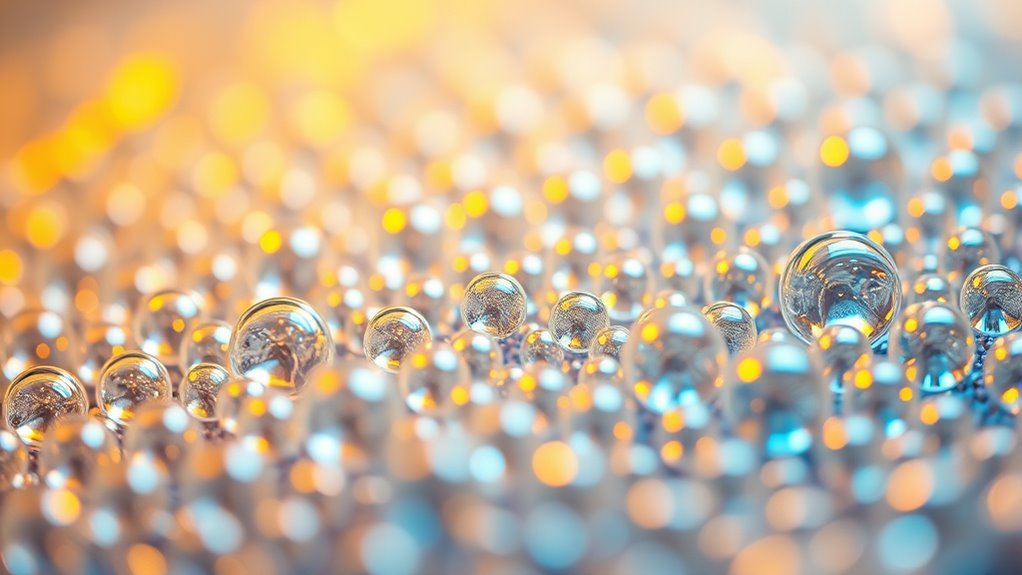
Nanoencapsulation offers significant advantages across various industries by enhancing the delivery, stability, and efficacy of products. It guarantees active molecules are protected from degradation, leading to longer shelf lives. You also benefit from improved targeting, which increases the effectiveness of your formulations. Additionally, nanoencapsulation allows for controlled release, reducing doses and minimizing side effects. Here are four key benefits:
- Increased stability of sensitive ingredients
- Enhanced bioavailability and absorption
- Precise targeting of specific sites
- Reduced dosage frequency and side effects
These advantages help industries like pharmaceuticals, food, cosmetics, and agriculture deliver safer, more effective products. Nanoencapsulation transforms how you formulate and deliver active compounds, making products more reliable and efficient. The integration of advanced AI capabilities in nanotechnology is expected to further optimize these delivery systems.
Challenges and Limitations of Nanoencapsulation Technology
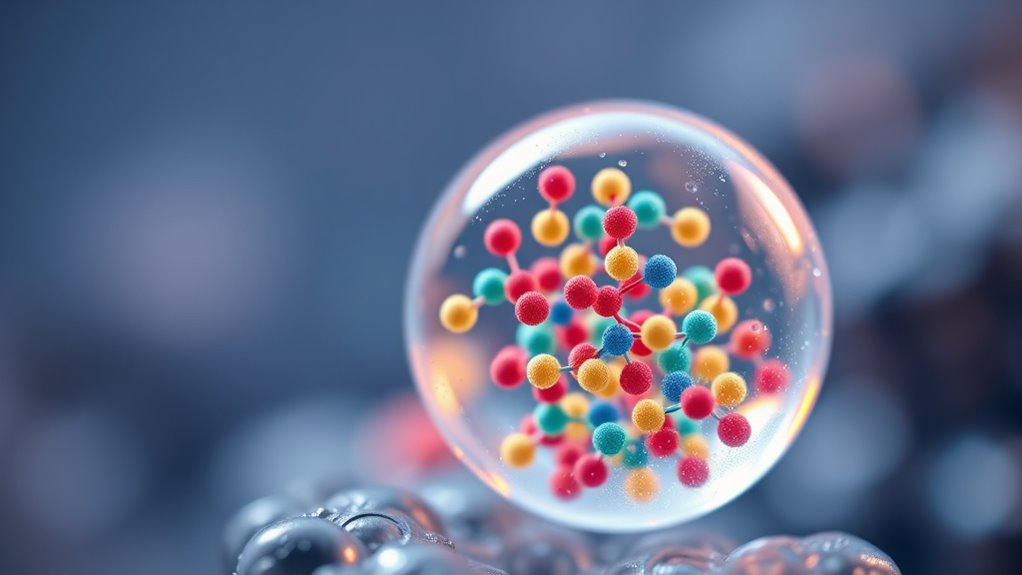
Despite its many benefits, implementing nanoencapsulation technology faces significant challenges that can hinder its widespread adoption. One major obstacle is scalability; producing nanocarriers consistently at an industrial level remains complex and costly. Stability is another concern—nanoparticles can degrade or aggregate over time, reducing effectiveness. Additionally, safety and regulatory issues pose hurdles, as long-term biocompatibility isn’t fully understood. You also need to contemplate environmental impact, since nanoparticle disposal might have unknown effects. Furthermore, color accuracy influences the overall performance of nanocarriers, impacting their effectiveness in various applications.
Applications in Pharmaceutical Development
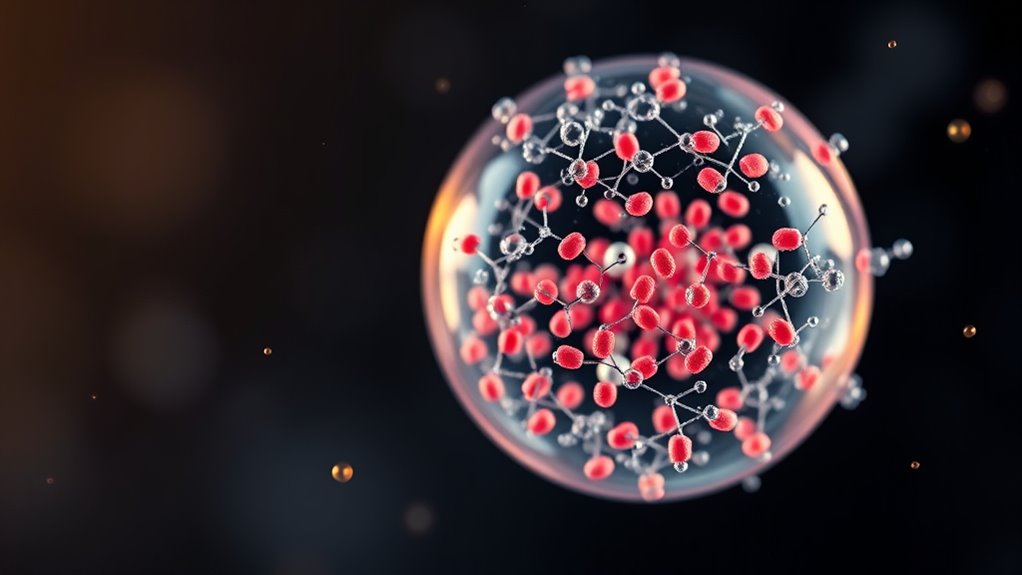
Nanoencapsulation improves drug stability, ensuring your medications remain effective longer. It enables targeted delivery, so drugs reach specific cells or tissues more efficiently. Additionally, it offers controlled release, helping you maintain ideal therapeutic levels over time. Understanding financial impact of innovative drug delivery methods can also influence industry investments and research funding.
Enhanced Drug Stability
Enhanced drug stability is a essential benefit of nanoencapsulation in pharmaceutical development, helping to protect active ingredients from degradation caused by environmental factors like light, heat, and moisture. With nanocarriers, you can:
- Prevent oxidation, preserving drug potency over time.
- Shield sensitive molecules from UV and visible light damage.
- Reduce moisture-induced hydrolysis, extending shelf life.
- Minimize temperature-related degradation, ensuring consistent efficacy.
- Incorporate advanced delivery systems that optimize targeted release and absorption.
These protections allow for longer storage periods, wider distribution, and improved reliability of medications. Nanoencapsulation creates a barrier around the drug, preventing environmental factors from breaking down active compounds. As a result, you get more stable formulations that maintain their therapeutic effects throughout their shelf life, reducing waste and enhancing patient safety. This stability is essential for delivering effective, dependable medications in modern pharmaceutical practices.
Targeted Delivery Systems
Targeted delivery systems leverage nanoencapsulation to direct drugs precisely to specific cells or tissues, increasing treatment effectiveness while minimizing side effects. By attaching targeting ligands, such as antibodies or peptides, to nanocarriers, you can guarantee the drug accumulates where it’s needed most. This precision reduces exposure to healthy tissues, lowering toxicity and adverse reactions. Nanoencapsulation also enhances drug solubility and stability, making it easier to deliver fragile molecules. These systems improve bioavailability and allow for lower dosages, which benefits patients and reduces costs. In pharmaceutical development, targeted nanocarriers enable personalized medicine approaches, offering treatments tailored to individual patient profiles. Overall, they represent a significant advancement in achieving safer, more efficient therapies.
Controlled Release Mechanisms
Controlled release mechanisms utilize nanoencapsulation to regulate the timing and location of drug release within the body, optimizing therapeutic outcomes. This approach guarantees drugs are released gradually or at specific target sites. Here’s what you need to know:
- Sustained Release: Maintains consistent drug levels over time, reducing dosing frequency.
- Stimuli-Responsive Release: Activates drug delivery in response to pH, temperature, or enzymes.
- Targeted Delivery: Combines controlled release with targeting, minimizing side effects.
- Enhanced Bioavailability: Improves absorption and stability of fragile molecules.
- Additionally, understanding vetted formulations ensures the safety and effectiveness of nanoencapsulation strategies in pharmaceutical development.
Role in Food Preservation and Functional Foods
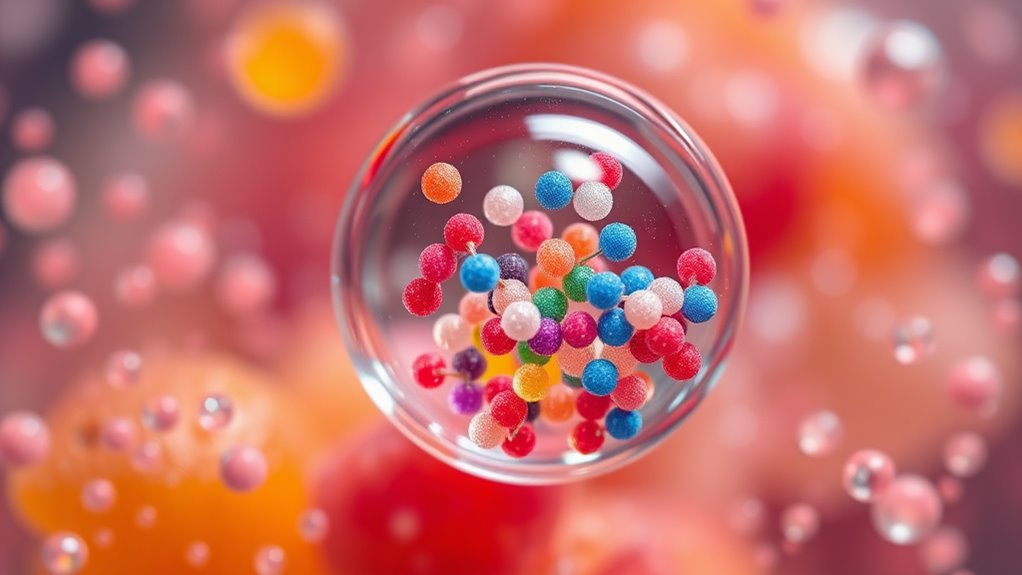
Have you ever wondered how tiny particles can extend the shelf life of your favorite foods or boost their health benefits? Nanoencapsulation plays a crucial role here. It protects sensitive nutrients like vitamins, antioxidants, and flavors from degradation, ensuring freshness and potency. This technology also enhances the bioavailability of nutrients, making them more effective in functional foods. By controlling release rates, nanocarriers help maintain stable textures and flavors over time. To illustrate, consider this table:
| Benefit | Impact |
|---|---|
| Extended shelf life | Preserves food quality longer |
| Improved nutrient stability | Maintains nutrient potency |
| Enhanced bioavailability | Increases health benefits |
Embracing nanoencapsulation transforms everyday foods into powerful, health-boosting options.
Future Directions and Emerging Trends
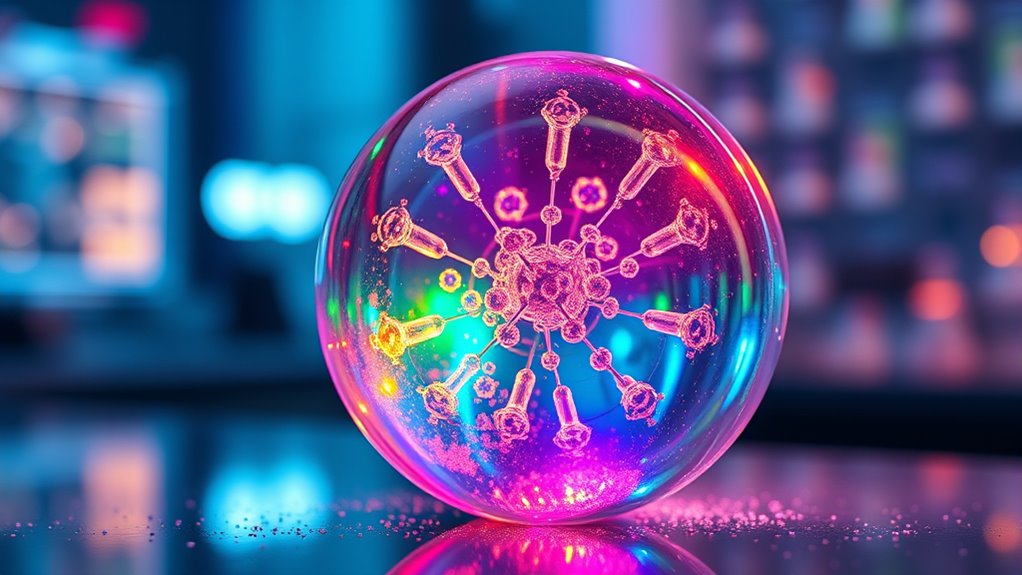
As research advances, the future of nanoencapsulation is poised to see significant innovations driven by new materials, manufacturing techniques, and environmental considerations. You can expect breakthroughs that improve efficiency and sustainability. Emerging trends include:
- Development of biodegradable nanocarriers to reduce environmental impact.
- Advanced manufacturing methods like microfluidics for precise and scalable production.
- Integration of smart release systems that respond to specific stimuli.
- Utilization of novel, eco-friendly materials for enhanced stability and biocompatibility.
These innovations will enable more targeted delivery, improved protection, and environmentally conscious solutions. Staying abreast of these trends will help you leverage nanoencapsulation’s full potential in diverse applications, shaping the future landscape of nanotechnology.
Regulatory and Safety Considerations
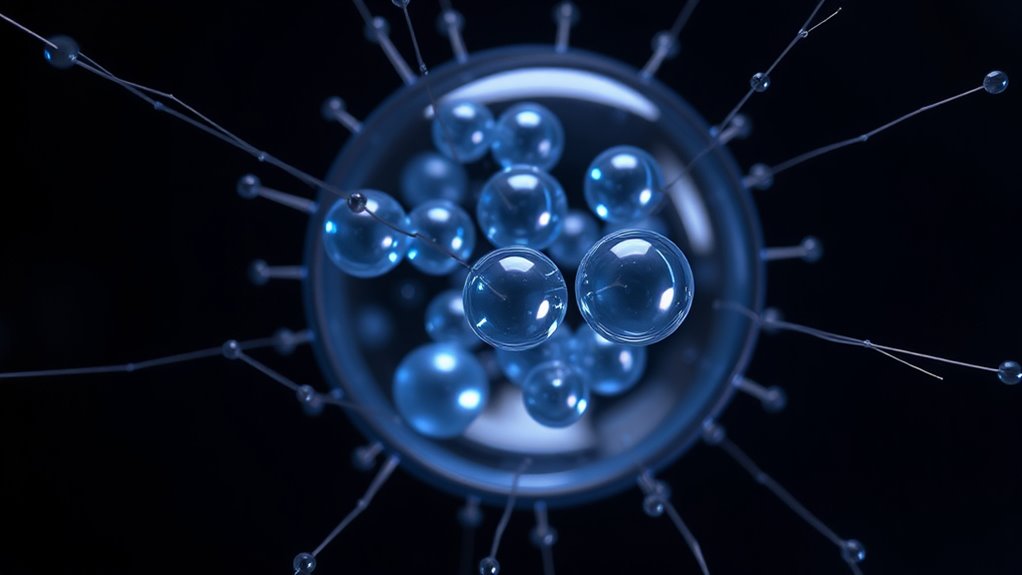
Advancements in nanoencapsulation technologies bring promising benefits, but they also raise important regulatory and safety concerns that must be addressed. You need to understand that nanocarriers may behave differently in biological systems, potentially causing toxicity or environmental issues. Regulatory bodies are working to establish guidelines, but standards vary globally. Ensuring safety involves testing for biocompatibility, stability, and long-term effects. To help visualize these considerations, here’s a quick overview:
| Aspect | Concern | Action Needed |
|---|---|---|
| Toxicity | Potential adverse health effects | Rigorous safety assessments |
| Environmental Impact | Persistence and bioaccumulation | Eco-toxicological studies |
| Regulatory Approval | Lack of standardized guidelines | Development of global regulations |
Frequently Asked Questions
How Does Nanoencapsulation Affect the Bioavailability of Active Compounds?
Nanoencapsulation enhances the bioavailability of active compounds by safeguarding them from degradation in the digestive system and improving their solubility. You’ll notice better absorption and increased effectiveness because nanocarriers allow the molecules to cross biological barriers more easily. This targeted delivery ensures that a higher percentage of the active ingredient reaches the bloodstream, making the supplement or medication more efficient and potent.
What Are the Environmental Impacts of Nanocarrier Disposal?
You might think it’s a walk in the park, but disposing of nanocarriers can pose environmental risks. These tiny particles may accumulate in ecosystems, potentially harming aquatic life and disrupting natural processes. If you’re not careful, nanocarrier waste could lead to pollution that’s tough to clean up. Proper disposal and regulation are essential to prevent unintended consequences, ensuring we protect both our environment and future generations.
Can Nanoencapsulation Target Specific Cells or Tissues?
Yes, nanoencapsulation can target specific cells or tissues. You can design nanocarriers with surface modifications like ligands or antibodies that recognize particular cell markers. This allows you to direct the encapsulated molecules precisely where needed, increasing effectiveness and reducing side effects. By customizing these nanocarriers, you guarantee that your therapeutic agents reach the intended sites, enhancing treatment outcomes and minimizing unintended interactions in the body.
How Scalable Are Nanoencapsulation Techniques for Industrial Production?
Sure, scaling up nanoencapsulation techniques is a breeze—if you enjoy tackling complex challenges. While lab methods are precise, industrial production demands large-scale consistency, cost-efficiency, and quality control. Companies are investing heavily to adapt these processes, making them more feasible for mass manufacturing. So, yes, with enough innovation and resources, you can turn intricate nanotech into everyday solutions, even if it’s not quite as straightforward as it sounds.
What Are the Long-Term Safety Implications of Nanocarrier Use?
You should be aware that the long-term safety implications of nanocarrier use are still being studied. Potential concerns include toxicity, environmental impact, and unintended biological interactions. While current research shows promise, you need to stay informed about new findings and regulatory updates. Continuous monitoring and rigorous testing are essential to guarantee these nanocarriers are safe for long-term use in medical, food, or industrial applications.
Conclusion
Nanoencapsulation acts like a shield, safeguarding molecules much like a knight guards a treasure. As you explore its evolving landscape, you’ll see it transforming industries with innovative solutions. Though challenges remain, ongoing research brightens the path forward, promising a future where tiny carriers reveal big possibilities. Embrace this technology’s potential, and you’ll find yourself at the forefront of a revolution, turning small wonders into mighty advancements for health, food, and beyond.
